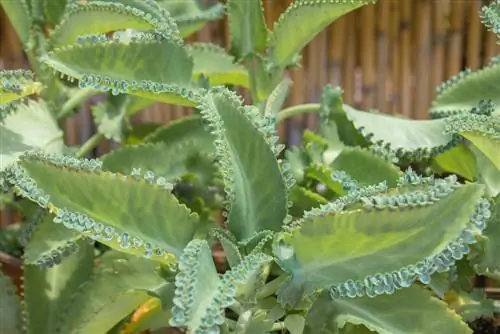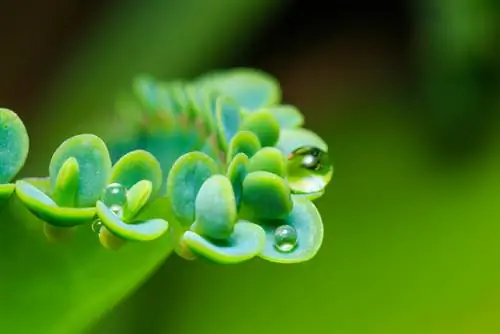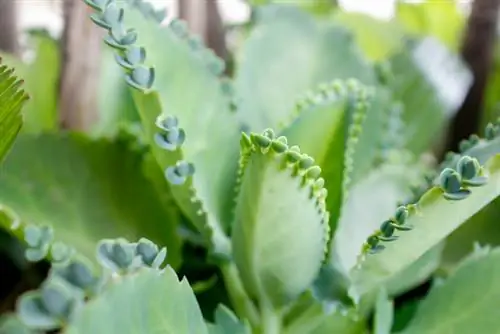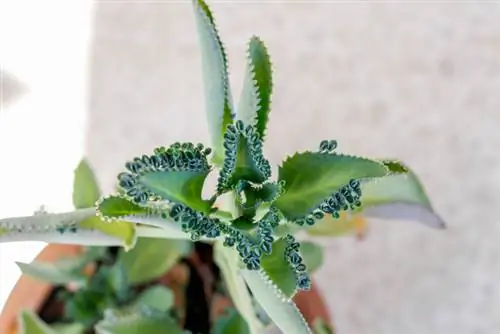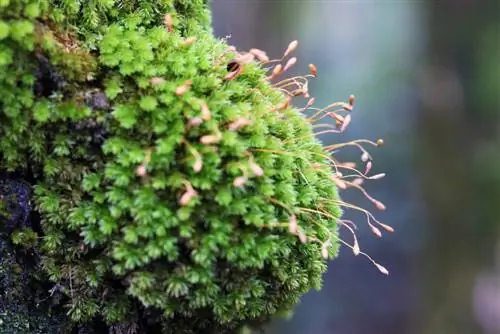- Author admin [email protected].
- Public 2023-12-16 16:46.
- Last modified 2025-06-01 06:02.
Every hobby gardener has heard of the brood leaf. The phenomenal houseplant breeds its offspring on the edges of its leaves. Picturesque flowers and beautifully shaped decorative leaves impressively round off the fascinating performance. Does the exotic piece of jewelry come with lofty claims? A look at the profile, planting and care provides good information. Find out everything you need to know about the fascinating brood leaf as a representative houseplant with tips for planting, propagation and care.
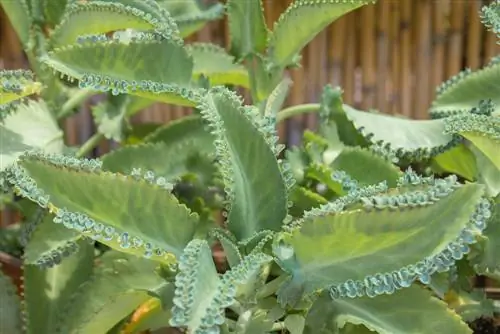
How do you properly care for a brood leaf?
The ideal way to care for a brood leaf is to plant it in cactus soil or a mix of potting soil, sand and lava granules, water sparingly with rainwater, fertilize rarely, use the edges of the leaves for propagation and only cut when necessary.
Profile
- Scientific name: Bryophyllum
- Family: Crassulaceae
- Genus: Kalanchoe
- Origin: Madagascar
- Growth type: Succulent
- Growth height: 10 to 150 cm
- Flower: tube-bell-shaped, simple
- Leaf: simple, pinnate, lobed
- Toxicity: poisonous or non-toxic
- Root: terrestrial, on brood bud
- Winter hardiness: not hardy
- Use: houseplant, medicinal plant
Bloom
Sightseeing flowers adorn brood leaf species in decorative shapes and picturesque colors. The following characteristics characterize a brood leaf flower:
- Structure: terminal, stalked umbrella cluster, umbel or panicle
- Composition: four to fivefold, mostly fused, rarely free
- Shape: simple chalice, hanging bell or tube
- Colors: white, red, pink, yellow, orange (varieties also two-color)
Some brood leaves do not have a flower dress, such as cat's ear, also known as panda plant (Kalanchoe tomentosa). To compensate, artistically shaped, velvety leaves with colorful hairs along the edges of the leaves decorate the exotic room beauties.
Toxicity
The poison content of brood leaf species is a double-edged sword. The classifications range from non-toxic and beneficial to toxic. Scientific studies and findings on the topic of Bryophyllum toxicity are far from complete. The following table gives examples of safe and problematic Kalanchoe varieties:
| Name | Goethe plant | Broodleaf | Flaming Käthchen | Elephant Ear | Desert Cabbage |
|---|---|---|---|---|---|
| Scientific name | Kalanchoe pinnata | Kalanchoe daigremontiana | Kalanchoe blossfeldiana | Kalanchoe beharensis | Kalanchoe thyrsiflora |
| Toxicity | non-toxic/he althy | poisonous | poisonous to animals | poisonous | slightly toxic |
| Status | Medicinal plant | Houseplant | Houseplant | ornamental plant | ornamental plant |
| Symptoms upon consumption | Contract inhibitors | Nausea | Shaking convulsions | Heart problems | Digestive problems |
| herbal Valium | Vomiting | Difficulty breathing | Skin Irritation | Skin Irritation | |
| Lowering blood pressure | Circulatory problems | Symptoms of paralysis | Stomach cramps | Nausea | |
| Wound healing | Heart racing | ||||
| Antidiabetic | Muscle weakness |
Root
Bryophyllum don't stop at spreading their roots in potting soil. Numerous breeding buds with their own roots sprout along the edges of the leaves. The result of this ingenious, vegetative and asexual propagation are tiny clones of the mother plant. A breath of wind is enough and the plants fall to the ground to take root. The name breeding leaf refers to this ingenious propagation strategy, as the following video demonstrates:
Video: Ingenious usage strategy - brood leaf clones itself
Winter hardiness
Brood leaves are not hardy. A look at the origin and distribution area reveals why this is the case. Broodleaf species are native to the tropical island state of Madagascar. Since their discovery at the beginning of the 19th century, the most beautiful Kalanchoe varieties have enjoyed worldwide recognition and have now gone wild in many tropical regions. On their journey around the globe, the thick-leaf plants have of course not learned to survive at temperatures below 10° Celsius.
Planting brood leaf - instructions
Garden centers usually sell young brood leaves in nursery pots with a diameter of 6 to 15 cm. Buy a matching flower pot with a diameter that is approximately 2 cm larger. Choose a shallow pot or planting tray to suit the shallow root system. How to plant a brood leaf correctly:
Location
The brood leaf feels well cared for in a sunny, warm location at room temperatures of 18° to 25° Celsius. Ideally, you reserve a place on the south-facing windowsill for the tropical houseplant. Bright, warm locations on the west or east window, in the winter garden and in a light-flooded hallway are also possible.
From May to September, a brood leaf will be happy to keep you company on the sunny balcony. A two-week hardening phase in a partially shaded location effectively prevents leaf damage caused by sunburn. If the nighttime temperatures fall below 12° Celsius, please put the Kalanchoe away again.
Substrate
In their home regions, brood leaves thrive in sandy, permeable, calcareous soil. The potting substrate should be designed accordingly. Commercially available cactus soil is well suited. Alternatively, mix it yourself using this recipe:
- Potting soil (permeable without peat): 50%
- Sand (fine-grained): 20%
- Lava granules or expanded clay: 30%
Plants
Please wear gloves to protect yourself from direct skin contact with the slightly poisonous plant sap. How to properly pot a brood leaf:
- Create a drainage system made of lava granules on the bottom of the pot or place a piece of clay over the water drain
- Fill in the substrate up to half to three-quarters of the height of the pot
- Make a small depression in the substrate
- Pull the brood leaf out of the seed pot
- Place in the middle of the hollow
- Fill in the remaining soil and press down
Plant a brood leaf at the same depth as in the nursery pot. Last but not least, water the plant with rainwater or stale tap water. To prevent waterlogging from forming, check the saucer after 10 minutes and pour off any accumulated water.
Excursus
Goethe's green muse - Kalanchoe pinnata
A type of brood leaf is popularly called the Goethe plant. Johann Wolfgang von Goethe was so fascinated by Kalanchoe pinnata that he went among amateur gardeners. His observations during the breeding process inspired the great German poet to write poems and treatises. He even included a brood sheet in his famous letter of April 19, 1830 to Marianne von Willemer.
Maintaining Brood Leaf - Tips & Tricks
As thick-leaved plants, brood leaves are among the succulent species. This results in low-maintenance care that you can successfully master even without a green thumb. Read the best tips and tricks for magnificent Kalanchoe as houseplants here:
- Watering: Water sparingly with rainwater, allow the substrate to dry noticeably before each watering (finger test (€14.00 at Amazon)).
- Fertilizing: From May to August, fertilize liquidly every 4 weeks with succulent fertilizer at half the concentration.
- Overwintering: Overwinter in a bright and cool place at 12° to 15° Celsius, water rarely, do not fertilize.
- Cutting: Thin out brood leaves in spring, cut back excessively long shoots (don't forget gloves).
- Repotting: Repot into fresh substrate at the end of February/beginning of March.
You will rarely have to complain about diseases and pests. The most common care problem is waterlogging. Wet feet are a sure way to bring down any succulent houseplant, especially during wintering. A safe method against overwatering is a watering indicator, on the scale of which the water requirement can be read. Occasionally a brood leaf is attacked by aphids. An effective home remedy against pests is the classic soap solution.
Propagation
Hobby gardeners take advantage of the phenomenon of rooted children on the edges of leaves for propagation. To turn the plants into lush beauties of brood leaves, proceed as follows:
- Fill the shallow planting bowl with unfertilized coconut soil or peat-free planting soil
- Drill small holes in the substrate with a pricking rod
- Pluck rooted, at least 2 cm large children from the edge of the leaf
- Insert plants
- Push the substrate with a stick over the roots until just below the base of the leaves
- Pour with a fine spray of lime-free water
In a bright, not full sunny location at temperatures of 15° to 20° Celsius, spray cuttings and dried soil sparingly with room temperature water.
Popular varieties
Attractive brood leaf species and representative varieties for the windowsill and the summer balcony come together under the umbrella of the genus Kalanchoe:
- Kalanchoe daigremontiana: red or pink tubular flowers from December to February, 30 to 150 cm tall.
- Kalanchoe laetivirens: Elephant ear, heart-shaped leaves, notched leaf edges, green-white or pink flower tubes, 20 cm small.
- Kalanchoe pinnata: Goethe plant, 50 to 100 cm tall, violet-red, hanging tubular flowers from July to September.
- Kalanchoe tubiflora: orange, tubular flowers from January to May, 75 to 90 cm tall.
- Kalanchoe delagoensis: Synonym for Kalanchoe tubiflora, tubular-flowered brood leaf.
FAQ
Is a brood leaf poisonous to cats?
All brood leaf species are poisonous to cats. Veterinarians particularly warn against popular houseplants such as Flaming Cat (Kalanchoe blossfeldiana), Goethe Plant (Kalanchoe pinnata) and Kalanchoe daigremontiana (Brutblatt). It's no use putting the thick-leaf plants out of your cat's reach. The poisonous plants fall unnoticed from the leaf edges of a mother plant and are destroyed. Your pet will have to pay for this little snack with severe nausea, painful vomiting and even life-threatening cardiac arrhythmias.
What ailments does brood leaf tincture work against?
In pharmacies you can buy brood leaf tincture as a homeopathic medicine. When used externally, the concentrated plant juice works against skin problems such as herpes and inflammation. When used internally, the natural remedy is said to have a soothing effect on sleep disorders, restlessness, coughs, sore throats or irritable bladders. Naturopaths also use brood leaf tincture as a labor inhibitor to prevent premature birth.
When should a brood leaf be repotted?
If the brood leaf pot is too crowded, it is recommended to change to a larger container with fresh potting soil. You should repot the Kalanchoe at the latest when the roots grow out from under the bottom of the pot. The best time is early spring, preferably March.
How hardy is an outdoor Kalanchoe?
Plants declared as outdoor Kalanchoe are not hardy. It is usually the well-known variety 'Flammendes Käthchen', which you can plant in the bed in May. After all, the tropical thick-leaf plant is quite robust and delights with colorful flowers well into autumn. If temperatures fall below 5° Celsius, the outdoor Kalanchoe dies. In the pot on the balcony, thickly wrapped in winter fleece in a sheltered location, the plant lasts until the first frost.
My brood leaf is losing leaves. What to do?
When succulent plants lose their leaves, waterlogging is the most common cause. Repot the brood leaf promptly in cactus soil over expanded clay drainage. From now on you will water more sparingly, always after a finger test. Brood leaves tolerate drought without any problems because plenty of water is stored in the fleshy leaves as a natural cistern.

